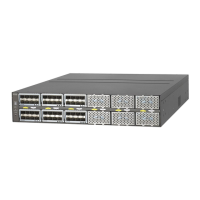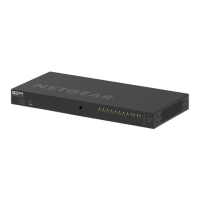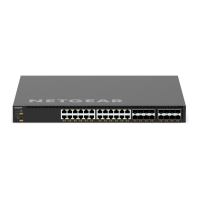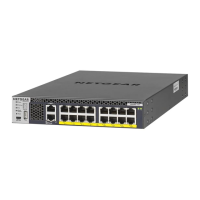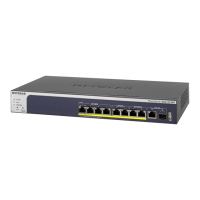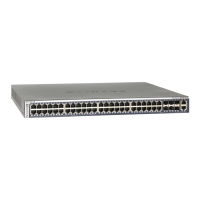Configure Switching Information
199
M4100 Series Managed Switch
11. Use STP Mode to enable or disable the Spanning Tree Protocol administrative mode
associated with the LAG.
The possible values are as follows:
• Disable — Spanning tree is disabled for this LAG.
• Enable — Spanning tree is enabled for this LAG.
12. Use Static Mode to select enable or disable.
When the LAG is enabled, it does not transmit or process received LACPDUs, for
example, the member ports do not transmit LACPDUs and all the LACPDUs it can
receive are dropped.
The factory default is disabled.
13. Use Link T
rap to specify whether a trap is sent when link status changes.
The factory default is enabled, which causes the trap to be sent.
14. Click the APPL
Y button.
The settings are sent to the switch. Configuration changes take effect immediately. These
changes are not retained across a power cycle unless you save the configuration. See
Save Configuration on page 405.
The following table describes the nonconfigurable information displayed on the screen.
Table 63. LAG Configuration
Field Description
LAG Description Enter the description string to be attached to a LAG. It can be up to 64
characters in length.
LAG ID Identification of the LAG.
Configured Ports Indicate the ports that are members of this port channel.
Active Ports Indicates the ports that are actively participating in the port channel.
LAG State Indicates whether the Link is up or down.
Configure LAG Membership
You can select two or more full-duplex Ethernet links to be aggregated together to form a link
aggregation group (LAG), which is also known as a port channel. The switch can treat the
port channel as if it were a single link.
To configure LAG membership:
1. Prepare your computer with a static IP address in the 169.254.100.0 subnet, for
example, 169.254.100.201.
2. Connect an Ethernet cable from an Ethernet port on your computer to an Ethernet port on
the switch.
3. Launch a web browser
.
4. Enter the IP address of the switch in the web browser address field.
